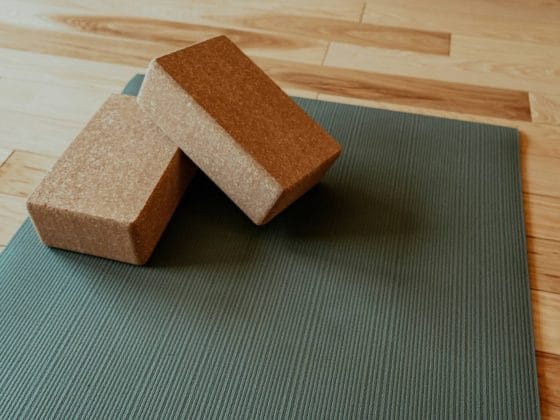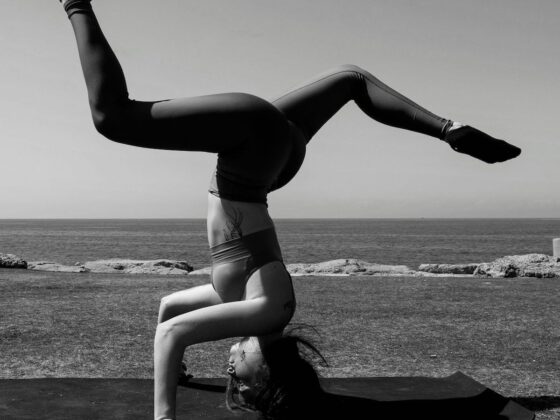Yoga is a transformative practice that nurtures the mind, body, and spirit. Whether you’re a beginner or an experienced yogi, one common question arises: How often should I practice Yoga?
When I finished my Yoga Teacher Training, I imagined myself practicing multiple hours a day, every day. Let’s just say, that wasn’t very practical – and I soon found myself going weeks without a practice.
Over the years I’ve experimented with multiple different routines and practices, as well as spoken to many Yoga teachers who have found their personal Yoga flow. And we all have one thing in common… we stopped believing that our personal Yoga practice had to look a certain way or check specific boxes.
The frequency of your Yoga practice depends on various factors, including your goals, schedule, and physical abilities. In this blog post, we explore the key factors that will allow you to establish a consistent routine that aligns with your needs and supports your overall well-being.

Listen to Your Body
If there’s one thing that really stands out about Yoga, it’s the emphasis on self-awareness. It’s essential to tune in to your body and listen to its needs.
For me, this meant releasing any expectations about the quantity and duration of my practice and instead focus on what my body was asking for.
Start with Realistic Goals
Set realistic expectations for your Yoga practice. Consider your current fitness level, flexibility, and any physical limitations you may have.
Gradually increase the frequency and intensity of your practice as you progress. Remember… your Yoga practice is yours and yours alone. You don’t have anything to prove (I’m talking to the over-achievers out there).
Quality over Quantity
Focus on the quality of your Yoga practice rather than the quantity. It’s better to have shorter, mindful sessions that leave you feeling rejuvenated than long sessions that leave you exhausted.
I had to make peace with the fact that, some days, my body needed some time away from my mat. And that’s OK, since it allowed me to show up as my best self on the days that my body was asking for a longer practice.
Consistency is Key
I got stuck in a my head A LOT when it came to my Yoga practice. I would say to myself that my practice didn’t count unless I did complicated poses or practiced at least 90 minutes a day. Unfortunately, this set me up for failure because I stopped enjoying my practice. And in my case, when I stop enjoying something, I see no point in doing it.
It’s only when I started focusing on consistency (AKA showing up every day in a way that I was able to), that I reconnected to the beauty that is Yoga. Some days I am able to do a long session while practicing difficult asanas, and on other days I do some simple stretches or breath work. The point is to show up every day in the best way that YOU can.

Tailor Your Practice to Your Goals
Your personal goals and intentions play a significant role in determining the frequency of your Yoga practice. Get clear on why you’re incorporating Yoga into your life and then assess the best way to achieve your desired outcome.
I incorporate Yoga as a way to relax and maintain my flexibility and mobility, since I do a lot of strength training and running. So, I aim to incorporate at least 20-30 minutes every day to achieve my goal.
General Health and Well-being
If you’re practicing Yoga for overall health and well-being, a consistent practice of 2-3 times per week can be beneficial.
This frequency allows you to experience the physical, mental, and emotional benefits of Yoga. Try to incorporate different styles of Yoga to gain the true benefits.
Flexibility and Mobility
If your goal is to improve flexibility and mobility, consider practicing Yoga 3-5 times per week for 45-60 minutes, or 20-30 minutes per day.
Regular stretching and gentle Yoga flows can gradually increase your range of motion and improve overall flexibility. I focus on Yin Yoga and gentle Vinyasa, which has improved my mobility and flexibility tremendously.
Strength and Stamina
For those seeking to build strength and endurance, a more rigorous practice is recommended. Aim for 3-6 sessions per week, incorporating dynamic Yoga styles such as Vinyasa or Power Yoga.
When I started practicing Yoga, I was doing Power Yoga 6 times per week for 60-90 minutes per session. In less than two weeks, I saw some serious strength gains. So, if this is your goal, Yoga can absolutely get you there!
Stress Reduction and Mindfulness
This has been one of the greatest benefits of adding Yoga to my life. Yoga’s calming and centering effects are particularly effective in reducing stress and promoting mindfulness.
Practicing Yoga 2-4 times per week can help you manage stress, cultivate inner peace, and improve mental clarity. Personally, I do about 10-15 minutes of meditation and breath work daily, which is easy to incorporate into any schedule.

Customize Your Practice to Fit Your Schedule
Finding the right balance between your Yoga practice and other commitments is crucial. Take a look at your schedule and setup a realistic practice for yourself.
Short Daily Practice
If your schedule is packed, aim for a short daily practice of 15-30 minutes. You can focus on specific poses, breathing exercises, meditation, or whatever you have time for.
Remember – there is no right or wrong way. This is YOUR practice and you are allowed to tailor it to what you need.
Longer Sessions on Non-Busy Days
On days when you have more time, schedule longer Yoga sessions. This allows you to dive deeper into your practice, explore more challenging poses, and experience a greater sense of relaxation.
Combine Yoga with Other Activities
If finding dedicated time for Yoga is challenging, integrate it into your daily activities. Do a few Yoga stretches while waiting for the washing machine to finish.
Practice some breath work while sitting in traffic. Challenge your kids to practice arm balances with you, or ask your significant other to help you get deeper into a stretch (which, if it isn’t obvious, could lead to some spice in other areas).
Do Yoga with Friends
Consider joining a Yoga studio or participating in group classes with your friends. You’ll more easily be able to fit in a scheduled class, while having the benefit of spending time with those you love! One of my favourite pass-times is doing a class with my partner and friends.
Afterwards, we all feel so relaxed and rejuvenated. It’s an awesome bonding experience, even if you don’t quite get to chat or sip on a glass of wine.

Adapting to Your Body’s Needs
Your Yoga practice should be adaptable to accommodate changes in your body, energy levels, and overall well-being. Our bodies go through natural cycles and it’s important to be gentle with yourself when you’re not feeling like your typical self.
For me, this was life-changing. I became more compassionate with myself and learned to treat myself with kindness.
Rest and Recovery
Just as important as regular practice is allowing time for rest and recovery. Listen to your body and take rest days when needed. Restorative or gentle Yoga practices can be beneficial during periods of fatigue, illness, or when recovering from intense workouts.
Modifications and Props
Don’t hesitate to modify poses or use props to support your practice. Yoga is a journey of self-discovery, and your practice should be tailored to your unique needs. Honour your body’s limitations and make adjustments accordingly.
Tune into Seasonal Changes
The frequency of your Yoga practice may vary with seasonal changes. During busier or more demanding periods, you might need to reduce the frequency temporarily. Be flexible and adapt your practice to align with the rhythms of nature and your own energy levels.
Consider Professional Guidance
If you have specific health concerns, injuries, or are pregnant, it’s essential to consult with a qualified Yoga teacher or healthcare professional. They can provide personalized guidance and help you determine the optimal frequency and type of practice.
Takeaway
The frequency of your Yoga practice depends on your goals, schedule, and individual needs. It’s crucial to listen to your body, set realistic expectations, and prioritize consistency over intensity.
Tailor your practice to align with your goals, whether it’s overall well-being, flexibility, strength, or stress reduction. Be flexible and adaptable, making modifications and taking rest days when necessary.
Remember that Yoga is a personal journey, and finding the right frequency for your practice will empower you to experience the transformative benefits of this ancient practice.
By developing a sustainable and adaptable Yoga routine, you can foster a deeper connection with yourself, enhance your physical and mental well-being, and cultivate a lifelong practice that nourishes your body, mind, and soul.



